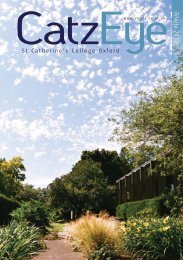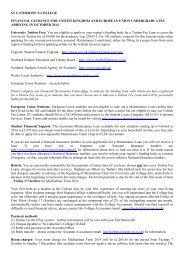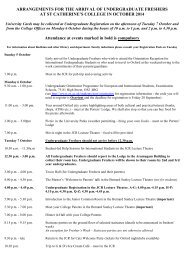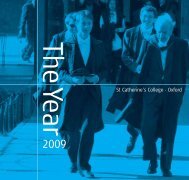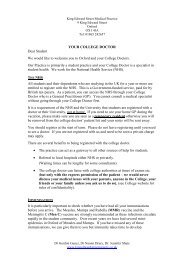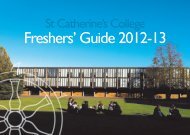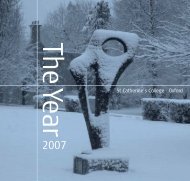Download PDF - St. Catherine's College
Download PDF - St. Catherine's College
Download PDF - St. Catherine's College
- No tags were found...
Create successful ePaper yourself
Turn your PDF publications into a flip-book with our unique Google optimized e-Paper software.
CATZ FELLOWSThat research currently involves two mainprojects: a monograph on theories ofinvention and technology, and a history ofthe European Patent Convention. The latter isparticularly exciting, for the Convention is thebasis of European patent law, and has neverbeen the subject of historical analysis.Written by a small group of people with astrong commitment to legal unification afterWorld War II, it took more than twenty yearsto write, and represents an important chapterin modern patent history as well as in modernEuropean law. In addition, that chapter is ofmore than purely academic interest, due inpart to the legal convention of resorting tohistory in order to resolve ambiguities inlegislative texts.Consider for example the use made of theConvention’s history in interpreting the law ofbiotechnology patenting.One of the most contentious provisions ofthe Convention is its exclusion from legalpatentability of plant and animal varieties,and certain methods of creating animalsand plants. According to the superior courtin this area, this exclusion is limited in scope,denying patent protection to single varietiesof animal or plant only. Thus, a single plantor animal, or method of creating differentvarieties, is potentially patentable. This is acontentious reading of the provision thatdepends on a view of the Convention’s literaltext described by a lower court as ‘defyingthe normal rules of logic’. In defending itsreading against that description, the superiorcourt relied on the history of the Conventionrecorded in certain unpublished travaux. In itsview, that history revealed the exclusion’spurpose as being to support the non-patentsystem of plant variety protection by ensuringthat inventions eligible for such protectionwould fall outside the scope of patentability.Something I enjoy aboutIntellectual Property lawis the possibility it offersfor interdisciplinarity.The reliance by a superior court on ananalysis of relatively inaccessible historicalmaterials to support a reading of acontentious legislative provision earlierdescribed by a different court as defyingthe normal rules of logic is striking. This isparticularly so when one studies the travaux,which do not obviously support the Board’sanalysis. Indeed, in work just completed Ihave argued for a different understandingof the exclusion’s history, grounded not in acommitment to harmonised protection, butrather, and on the contrary, a recognition byearly European framers that the question ofpatenting higher forms of life raised issues ofpublic interest importance inappropriate forresolution by harmonisation.Something I enjoy about intellectualproperty law is the possibility it offersfor interdisciplinarity. This makes <strong>College</strong>an attractive base for me, and I haveoccasionally used lunch as an opportunityto ask my non-legal colleagues about variousaspects of my current research. Indeed, inSeptember 2009, Catz Geography FellowDr Andrew Barry and I will be speaking atthe same interdisciplinary workshop inCambridge on theories of invention.In March 2009 Catz will host the sixthInternational Intellectual Property Mootrun by the University’s Oxford IntellectualProperty Research Centre, and in Septemberit will become the permanent home of theUniversity’s new Postgraduate Diploma inIntellectual Property Law and Practice.ST CATHERINE’S COLLEGE 2008/51



